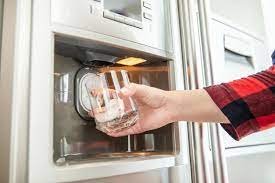A freestanding ice maker is a convenient appliance for ensuring a constant supply of ice, but like any other device, it may encounter issues that hinder its performance. Before reaching out for professional help, consider these troubleshooting steps to address common problems and get your freestanding ice maker back to producing ice efficiently.

1. Check Power and Connection:
Start by ensuring that your freestanding ice maker is plugged in and receiving power. Verify that the power cord is properly connected and that the outlet is functional. A loose connection or power outage may be the root cause of the problem.
2. Inspect Water Supply:
The ice maker requires a consistent water supply to produce ice. Confirm that the water reservoir is adequately filled, and the water supply line is connected securely. If there’s a water filter, check if it needs replacement, as a clogged filter can impede water flow.
3. Clean the Ice Maker:
Over time, mineral deposits and impurities can accumulate inside the ice maker, affecting ice production. Clean the ice maker according to the manufacturer’s guidelines. This may involve using a mixture of water and vinegar to remove scale and debris.
4. Check for Jammed Ice Cubes:
Inspect the ice maker for any jammed or stuck ice cubes that may be preventing the production of new ones. Gently remove any obstruction and ensure the ice storage bin is properly aligned.
5. Verify Temperature Settings:
Check the temperature settings of the ice maker. Ensure that the unit is set to the appropriate temperature for ice production. Extreme temperatures, either too cold or too warm, can impact ice production.
6. Reset the Ice Maker:
Many freestanding ice makers have a reset function. Refer to the user manual to locate and utilize the reset button or switch. This can help resolve minor glitches and restart the ice-making process.
7. Inspect the Condenser Coils:
Dirty or dusty condenser coils can hinder the ice maker’s efficiency. Regularly clean the coils using a soft brush or vacuum cleaner. Clearing away dust and debris helps maintain optimal performance.
8. Consult the Manufacturer’s Manual:
Refer to the manufacturer’s manual that came with your freestanding ice maker. It often contains specific troubleshooting tips and solutions tailored to your appliance model.
9. Professional Assistance:
If all else fails, and the issue persists, consider seeking professional assistance. A certified technician can diagnose and address more complex problems with your freestanding ice maker.
Troubleshooting your freestanding ice maker can often be a straightforward process. By following these steps and consulting the manufacturer’s guidelines, you increase the likelihood of identifying and resolving the issue, ensuring a continuous supply of ice for your needs.
LG Troubleshoot the Freestanding Ice Maker
https://www.lg.com/levant_en/support/product-help/CT20158016-20150356636625
Brand-Specific Ice Maker Troubleshooting Guides: Find Solutions for Your Appliance
- Hisense Refrigerator | Not Cooling Troubleshooting Tips: Watch this video
- Haier Ice Maker – Not Working: Haier Support
- Insignia Ice Maker NS-IMP26SS7 Troubleshooting: iFixit Wiki
- Kenmore Troubleshooting Guide for Freestanding Ice Makers: Appliance Blog
- What to Do if Your Ice Maker Is Not Working: Maytag Blog
- Sub Zero Ice Maker Does Not Make Ice: Sub-Zero/Wolf Support
- Bosch Ice Maker Not Working and Not Making Ice: iFixit Troubleshooting
- How to Troubleshoot the Freestanding Ice Maker: KitchenAid Product Help
- Electrolux Ice Maker Service Manual: Electrolux Support
- Opal Ice Maker – Not Making Ice: GE Appliances Support
- Ice Maker Troubleshooting: How to Fix an Ice Maker: Whirlpool Blog
- Fridge Freezer Ice Maker Not Working: Samsung Support







